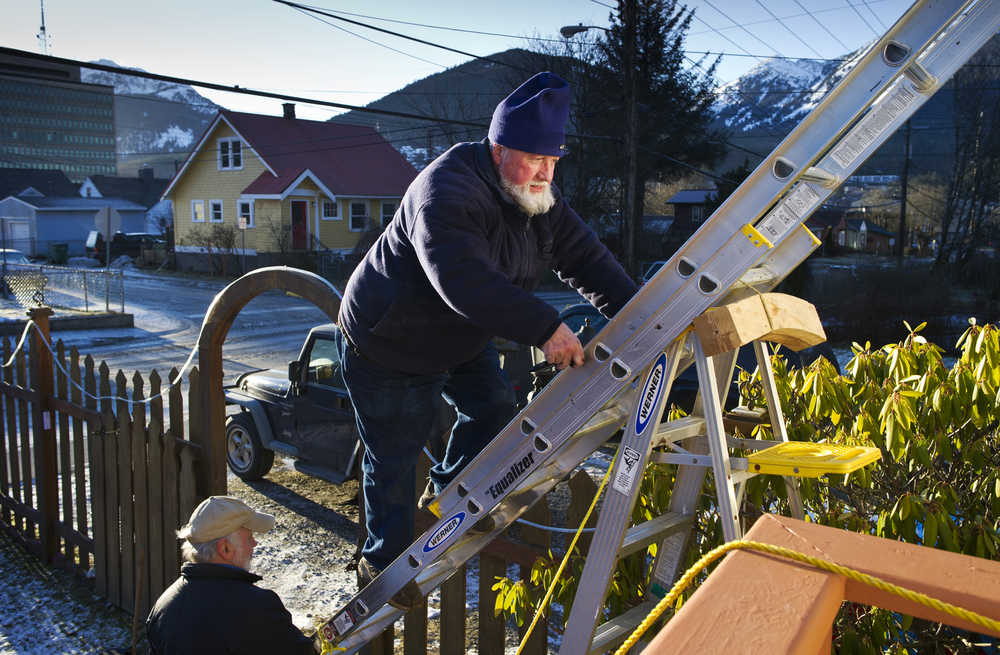Monday was a busy day for Chris Bradley.
As the weekend’s Taku windstorm calmed, Bradley – of Juneau Glass – was literally picking up the pieces.
“We had quite a few calls,” he said Monday morning.
In one case, the wind grabbed a skylight window that had been cracked open. “It just ripped the whole sash out,” Bradley said. “We put plywood over it.”
Bradley wasn’t the only person working hard Monday morning. According to the National Weather Service, a gust of 94 mph was recorded at Juneau’s downtown library Friday evening. That was the peak of a windy weekend, but lower gusts caused problems across the city, putting trees into power lines and tipping a shipping container into Gastineau Channel.
In the Juneau Flats, James Nelson spent Monday morning on his roof, hammering a handful of shingles back into place.
“I’ve been waiting for the last two days for the wind to calm down a little bit, and I said they’re going on today regardless,” he said by phone. “It hit here pretty hard.”
From his roof, Nelson could see three or four other homes in a situation similar to his own.
Nelson said it’s the first time he’s lost shingles since he moved into the home 12-14 years ago.
While the Taku (also called “mountain wave”) winds are a regular occurrence in Juneau, “we really haven’t seen one of this strength in about five years,” said National Weather Service meteorologist Tom Ainsworth.
Winds peaked Friday evening, and in addition to the high mark at the library, measuring stations across the city saw the effect. At the rock dump, there was a gust of 85 mph. At the federal building, the peak was 79 mph.
At higher elevations, winds were stronger. Sheep Mountain registered a gust of 119 mph. At Juneau Icefield Camp 18, the peak gust was 109 mph.
The winds receded somewhat Saturday but resurged Sunday. Douglas Harbor saw a gust of 63 mph. The rock dump had one of 44 mph. At the federal building, the peak wind was a 39 mph gust.
The old joke is that what Florida calls a hurricane, Alaskans call Tuesday. Ainsworth said the measurements across Juneau were peak gusts, not sustained winds – one of the many differences between a hurricane and what struck Juneau.
On Monday morning, damage – mostly limited to broken windows, blown objects and torn shingles – appeared light. In downtown Juneau, Heritage Coffee customers were disappointed to learn that the cafe’s kitchen would be closed until Tuesday – a kitchen ventilator had been damaged by the wind, and employees couldn’t use the oven.
On Friday, Alaska Electric Light and Power reported an outage Out the Road after winds knocked a tree into power lines at Mile 23 Glacier Highway. The outage lasted only two hours, and the power company didn’t report any other widespread outages the rest of the weekend.
The wind’s biggest effect was on transportation. Alaska Airlines flights were canceled or delayed, and the Alaska Marine Highway canceled its sailings between Juneau and northern Lynn Canal on Friday and Sunday.
The issue, said ferry system spokesman Jeremy Woodrow, was the heavy freezing spray whipped by the wind. That freezes to smaller ferries’ lifeboats and makes them unusable – a no-no for safe sailing.
“They wouldn’t be able to deploy those life rafts; that’s the only reason,” Woodrow said. “It’s not that the ship can’t handle the freezing spray.”
The ferry Kennicott was expected to arrive in Haines and Skagway on Monday, and a second ferry was scheduled for Tuesday to relieve the backlog.
Among those delayed by the wind were several Alaska legislators and their staff members, headed south before next week’s start of the legislative session.
“They’re full price-paying customers just like anybody else,” Woodrow said.
Posts on social media alleged the legislators were getting preferential treatment from the ferry system, but Woodrow denied that.
“Some people think we’re giving priority to Legislative vehicles, and that’s not really the case here,” he said.
When the ferry system has to rebook passengers, it gives preference to reservations made farthest in advance.
“A lot of these Legislative vehicles were booked months ago,” he said.
That’s leaving some people, like former Empire reporter Lisa Phu, stuck.
“Yes, I’m stuck, and other people are stuck too,” she said by phone Monday morning.
Phu was originally told by the ferry system that she, her 3-month-old son, her husband and their dog would be stuck in Haines until Sunday, Jan. 15.
Now, they’re on the wait-list for the Tuesday trip.
“If I have to be stuck anywhere,” she said by text message, “Haines is a pretty great place to be.”

